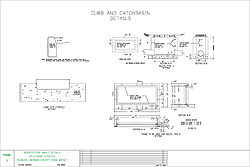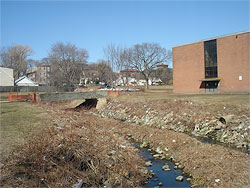Implementing Restoration Projects Upstream from the Teaneck Creek Conservancy
by Jeremiah D. Bergstrom1, Peter Kallin2, and
Christopher Obropta3
1Water Resources, TRC Environmental Corporation, Trenton, New Jersey 08628
2Belgrade Regional Conservation Alliance, P.O. Box 250, Belgrade Lake, Maine 04918
3Rutgers Cooperative Research and Extension, Rutgers University, New Brunswick, New Jersey 08901
Abstract
During initial investigations, scientists identified several off-site situations that were negatively affecting the health and diversity of the wetland and riparian habitats in the Teaneck Creek Conservancy restoration site. Significant off-site influences include high nitrogen inputs and non-point source pollution generated by a local hospital and the extensive presence of invasive species, chiefly Japanese knotweed (Polygonum cuspidatum), along the upstream banks of Teaneck Creek. This upstream source of high nitrogen loadings and the seeds of invasive species continues to threaten efforts to achieve a successful and sustainable long-term wetlands restoration on the Teaneck Creek Conservancy site. To address the nitrogen inputs, the restoration team has partnered with Holy Name Hospital, situated at the headwaters of Teaneck Creek, to develop a stormwater runoff management program. To address the downstream spread of invasive species, a partnership was formed with the Teaneck Board of Education to manage invasive species adjacent to the northern entrance to the Teaneck Creek Conservancy site. Working with the restoration project partners, Holy Name Hospital and the Teaneck Board of Education have developed plans to address stormwater runoff and erosion impacts, implement an invasive species management program in partnership with the U.S. Fish and Wildlife Service to control the Japanese knotweed, and reestablish a native riparian vegetative buffer along the entire length of Teaneck Creek upstream of the Conservancy property. Such alliances formed to deal with upstream factors illustrate the type of approach required to develop successful and sustainable long-term ecological restorations in urban areas.
Keywords: stormwater, restoration, stabilization, streams, wetlands, rain garden, invasive species
Introduction
A key obstacle to achieving successful and sustainable urban wetland restoration is the influence of off-site environmental conditions (Ravit et al. this volume). During the wetlands research and site investigations at the Teaneck Creek Conservancy, partners identified several off-site locations that were negatively impacting the health and diversity of the wetland and riparian habitats in the restoration site.
Teaneck Creek Headwaters
The headwaters of Teaneck Creek are located on property owned by Holy Name Hospital, which is immediately upstream of the Thomas Jefferson Middle School and the Conservancy restoration site. The hospital holds an NJDEP permit allowing the discharge of 100,000 gal day-1 of groundwater, which is pumped from the hospital basement into Teaneck Creek (Arnold this volume). This high quality discharge originates in a small garden and tumbles through a series of rocky pools toward Teaneck Road, approximately 300 feet south of the hospital. Two additional pipes from the hospital property discharge into Teaneck Creek before it reaches a culvert located under Teaneck Road and leading to the Thomas Jefferson Middle School property. The first pipe drains heated water from an on-site sterilization facility, and the second pipe contains stormwater runoff from the hospital parking deck and parking lots. There is a visible change in water quality in the stream where this nonpoint source (NPS) pollution enters the creek. In addition to these two pollution sources, runoff from slightly over an acre of parking lots flows southward, where it runs along a curb to a catch basin in the southwest corner of the parking lot (Figure 1). At this catch basin, the runoff enters a pipe and is immediately discharged into Teaneck Creek prior to the creek entering the Teaneck Road culvert. This water carries whatever pollutants (suspended solids, oil, grease, metals) are washed from the parking lot's asphalt surface. The site currently routes parking area runoff directly into Teaneck Creek. During winter months, the hospital uses urea to deice its parking structure, causing high loadings of ammonia to flow directly into Teaneck Creek.
Teaneck Creek Existing Conditions
The headwater flows originating at Holy Name Hospital combine in the storm sewer system (a total watershed drainage area of almost 300 acres) and then discharge through a 7-1/2-by-5-foot, elliptical concrete pipe onto the property of the Thomas Jefferson Middle School. Teaneck Creek flows through the school property for approximately 900 feet before entering a culvert located underneath Fycke Lane, which discharges into the northern entrance of the Conservancy. The upstream section of the stream consists of an open channel with extensive eroding bank areas (Figure 4). High velocity discharges from the culvert outfall pipe into the stream have undermined the stream banks and caused a portion of the side bank to collapse into the streambed, causing serious safety and liability concerns. The downstream section of the stream on school property has sloping banks, which are shallow enough to minimize erosion. However, as the stream abruptly turns near Fycke Lane before discharging into the Conservancy, its slope changes and the velocity along the bank increases, causing erosion near the twin box culverts exiting the school property (Figure 5). Due to the extensive presence of the invasive Japanese knotweed (Polygonum cuspidatum) plant, the stream bank areas and soils have become highly erodible. During heavy rainfall events, the Japanese knotweed is continually spread downstream from the school site into the forested wetlands and stream corridors of the Conservancy.
Restoration Approach
Teaneck Creek Invasive Control
One of the most significant off-site influences on this site is extensive invasive species colonization, dominated by Japanese knotweed, along Teaneck Creek at the Thomas Jefferson Middle School property immediately upstream from the restoration site (Figure 6). This upstream source of seed and stems continues to threaten the project's efforts to manage Japanese knotweed and other invasive species in the riparian and wetlands areas along Teaneck Creek. Once this source of invasive vegetation was identified, team members approached the Teaneck Board of Education and formed a partnership to repair Teaneck Creek as it flows through school property.
Stormwater Management
Holy Name staff contacted the Conservancy to identify steps the hospital could take to help with the wetlands restoration project. After discussions with the wetlands restoration scientists, it was determined that the most significant contribution the hospital could make would be to construct a rain garden on their property to treat runoff from the parking lot. The Rutgers Water Resources Program engineered an appropriate rain garden design to address the hospital parking area drainage patterns (Figures 2, 3).
The proposed rain garden design routes runoff from the parking lot through a set of curb cuts into a series of bioretention cells, which are incorporated into the landscaping between the hospital parking lot and Teaneck Road. The cells are designed to hold and infiltrate the NJDEP-designated, 1.25-inch Water Quality Storm. The cells are connected by grass swales that allow excess runoff from larger storms to be routed to the existing catch basin, bypassing the bioretention cells, thus minimizing erosion and damage to the rain garden system. This approach to stormwater management is designed to provide treatment for the runoff from approximately 90% of all precipitation events, significantly reducing suspended solids, oil, and grease runoff into Teaneck Creek (NJDEP 2004). The rain garden is scheduled for construction in the spring of 2008.
Stream Restoration and Stabilization
As the site exists today, high stream flows are causing substantial stream bank erosion in the Teaneck Creek reach adjacent to the school. This erosion creates hazardous conditions on the school property in the form of steep, unstable stream banks. To remedy this problem, the Teaneck Board of Education has proposed a stabilization and restoration project, whose goals include moderating high stream flows, stabilizing the stream banks and channel, and reestablishing a native riparian buffer. Working in conjunction with the Conservancy project partners, the Teaneck Board of Education has submitted permit applications to the New Jersey Department of Environmental Protection (NJDEP). The proposed school property restoration plan addresses existing stream bank erosion and stormwater impacts, implements an invasive species management program in partnership with the U.S. Fish and Wildlife Service to control the Japanese knotweed, and commits to reestablishing a native riparian vegetative buffer along the entire length of Teaneck Creek where it flows through the Thomas Jefferson Middle School property. The Conservancy partners are working closely with the Teaneck Board of Education to provide Best Management Practices (BMPs) that will reduce ongoing maintenance and improve school safety and liability issues, while improving and enhancing this valuable ecological resource.
In evaluating stream bank stabilization and restoration options on the school property, the engineering team prepared hydrologic and hydraulic calculations to determine stream flows and velocities during storm events (USACE 1991). Using hydrologic soil group, land use, and impervious cover percentages, the analysis calculated a composite curve number of 82 for the nearly 300-acre drainage area (Table 1). As part of the design of the stabilization and restoration plan, the team also calculated the flow and frequencies associated with various storms events that could potentially affect Teaneck Creek (Table 2). The first phase of this project will stabilize approximately 200 linear feet of stream channel immediately downstream from the existing 7-1/2-foot-by-5-foot reinforced concrete pipe outlet discharging onto the school property. This 200-foot segment is currently experiencing extreme erosion and sedimentation due to the pipe discharge. The project proposes regrading and stabilizing the stream banks with cobble and natural "rip-rap" stone, installation of live staking, and extensive planting of native riparian shrubs and trees. In addition, a stabilized outlet and boulder rock-vanes are proposed to reduce velocities and redirect flows away from the side banks and toward the center of the stream (Rosgen 2001). All proposed stream channel modifications have been designed to achieve no net fill within the stream channel and floodplain (Figure 7).
The second phase of the project is restoration and stabilization of stream banks along an additional 600 linear feet of stream (Figure 8). Work in this section will include removal of a pedestrian bridge crossing the stream, regrading of stream banks to a 3:1 slope, and construction of a 4-foot-wide safety shelf. The regrading activities will remove the invasive Japanese knotweed and establish native riparian vegetation. Plantings and stabilization efforts will be enhanced with the installation of coconut fiber logs and boulders and the use of erosion-control mat or turf-reinforced mat.
Urban Restoration Partnerships
When working in urban regions, wetland habitat restoration efforts should look beyond the borders of the specific project site to evaluate potential affects coming from upstream and other off-site sources (Wolin and Mackeigan 2005). Without investigating off-site areas, unpredictable and unexpected conditions related to stream flows, stormwater drainage, landscape management, and maintenance can significantly influence the success of a restoration effort. A key step in successfully building support for the Teaneck Creek Conservancy project has been the effort to identify key property owners, managers, and information sources and establish strategic partnerships beyond the borders of the project site. Through informal and public meetings, local education outreach efforts, and work with citizen volunteers, project partners have obtained valuable insights and information. By partnering with community leaders and neighboring property owners, scientists and engineers have shared knowledge and built trust within the community. These outreach activities will lead to additional ecological improvements beyond the original Teaneck Creek restoration site, helping to ensure the success of the Teaneck Creek restoration efforts.
Acknowledgments
Funding support for Teaneck Creek studies has been provided by the New Jersey Wetlands Mitigation Council. We thank the staff of the Rutgers Cooperative Extension Water Services group for their contributions to this project, and we gratefully acknowledge the support of Holy Name Hospital, the Teaneck Board of Education, and the Thomas Jefferson Middle School, Teaneck, NJ.








